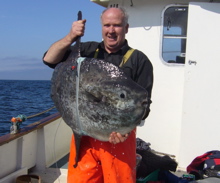2007 Press Releases
03.09.2007
A team of international scientists have succeeded in satellite tagging two ocean sunfish off the coast of Dingle. Dr Tom Doyle, Coastal and Marine Resource Centre, UCC together with Dr John Houghton of the University of Wales Swansea and other researchers from both Wales and Germany spent over two weeks studying the movements of sunfish off Smerwick harbour on the Dingle peninsula in Co. Kerry.
This is the first time that
these fish have been tagged in Irish and UK waters.
According to Dr Doyle, sunfish are the largest bony fish in the world and can grow up to 3.1m from tip (mouth) to tail fin, and weigh up 2235 kg (2 tonnes). He explained: "They have a unique shape that is flattened from side to side and stretched from top to bottom. Their body is truncated (or shortened) to such an extent that they are literally all head and no body. Their German name 'Schwimmender kopf' means 'swimming head'."
Unfortunately, almost nothing is known about the movements and
behaviour of these ocean giants. However, it is thought that during the
summer months, sunfish migrate into Irish coastal waters. The northern
coastline of the Dingle peninsula (from Smerwick Harbour to Brandon
Head) is one such area where they are regularly seen. The researchers believe the coastline may hold significant numbers of sunfish, with up to 20 individuals observed in a day. It is thought the coastline may represent a nursery ground for sunfish, where juveniles can shoal and feed together. Similar nursery grounds are known in Bali (Indonesia), and off the coast of California.
Each tag will record temperature, depth, and light data, from which the scientists can reconstruct the movements and behaviour of these two fish. The first data is due to be transmitted via satellites in two months time. By then the sunfish may be located off the continental shelf or towards the Bay of Biscay and Portugal.
Taighde Mara Teo, an Irish fisheries research group, provided
logistical and technical support while support and local knowledge were
provided by Pádraig Frank Eco-Tours based out of Ballydavid, Smerwick
Harbour. The Marine Institute and Údaras Na Gaeltachta generously
funded this research.
Dr Doyle who organised the expedition said, "This research has very important implications for Ireland as a whole as sunfish may represent a good biological indicator of climatic change, that is... if sunfish sightings increase dramatically it may be a clear sign that our climate is changing."
Dr Jon Houghton of University of Wales Swansea said, "The northern coast of Dingle represents an important habitat for sunfish, and provides a fantastic opportunity to study the behaviour and biology of these ocean giants."
Picture shows: Pádraig Frank O’Súilleabháin with sunfish onboard his eco-tourism boat Miss Fiona
Photo © Dr Nikolai Liebsch.
506MMcS

